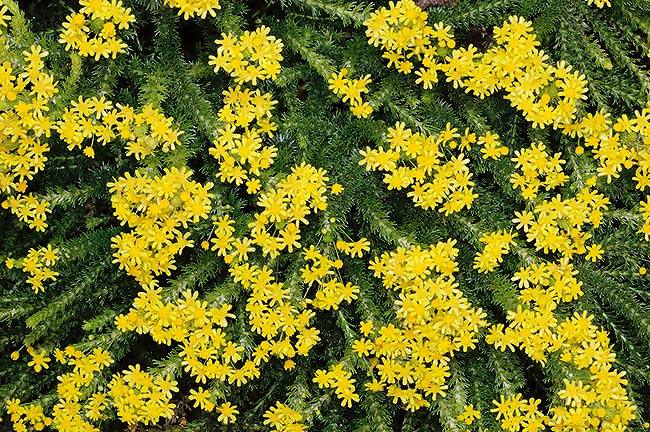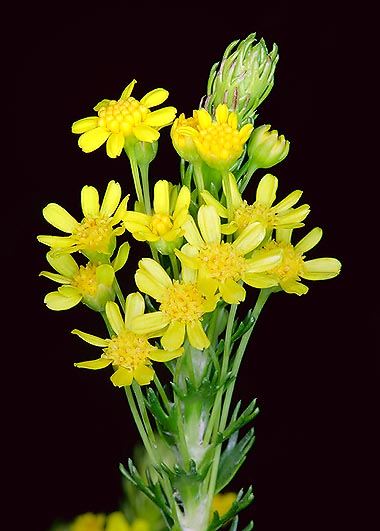Family : Asteraceae

Text © Pietro Puccio

English translation by Mario Beltramini

Euryops virgineus in winter-spring covers with a crowd of small flowers © Giuseppe Mazza
The name of the genus is the combination of the Greek words “eurys” = ample and “ops” = look, with reference to the abundant blooming, after some, to the size of the single flower, after others; the name of the species is the Latin word “virgineous” = virginal, chaste, of not clear reference.
Common names: rivierharpuisbos, heuningmagriet (Afrikaans); honey euryops, river resin bush (English).
The Euryops virgineus (L.f.) DC. (1838) is an erect ramified shrub, evergreen, up to 3 m tall, but usually does not exceed the 1,2-1,5 m and 3 m broad.
It has cylindrical stems with alternate close leaves, sessile (without petiole), palmate-lobate with 3 to 7 lobes, of dark green colour, 0,5-1,5 cm long and 0,3-0,8 cm broad. The solitary inflorescence, axillar, with a diameter of 0,7-1 cm , are the typical flower heads of the Asteraceae, formed by a host of sessile flowers spirally inserted on a roundish base, the receptacle, surrounded by an involucre formed by 5-8 linear bracts, pointed and united at the base. The flowers of the outer ring, called ray florets, usually 8, have the oblanceolate corolla formed by five petals united together and of a bright yellow colour.

The 7-10 mm inflorescences smell of honey © Giuseppe Mazza
The fruits, containing one seed only and called achenes (or, more correctly, cypselae) in the Asteraceae, are oblong, yellow of pale brown, 2-2,5 mm long, surmounted by the pappus, the modified calyx of the flower, which has the function to help their dispersion, formed by a short tuft of white hairs.
It reproduces by seed and, very easily, by cutting in summer, in sand or agri-perlite, which roots in 2-3 weeks.
Plant of easy cultivation and of very fast growth, which in winter-spring covers of a multitude of small flowers with a bright colour and a slight scent of honey, so much to almost hide completely the green part. It is particularly suitable for the Mediterranean climates, best for hedges, back borders, isolated specimen or in the rocky gardens, in full sun or in very slight shade; useful, for its fast growth, in new gardens, for filling up the empty spaces.
It is not particularly demanding about soil, provided the same is well drained; in summer the watering must be regular, but spaced, in such a way to dry up the soil, and once well rooted, it may bear drought periods.
It resists to the wind and to the saline aerosols, it may be employed, therefore, close to the sea, and, moderately, at low temperatures, as low as -8/-10 °C.
Time passing, it tends to widen in a rather messy way, and to loose the leaves close to the base, drastic pruning are consequently necessary in spring, after the blooming, for the renewal, and in autumn for a more compact form.
Synonyms: Othonna virginea L.f. (1782); Euryops flabelliformis Cass. (1817); Jacobaeastrum virgineum (L.f.) Kuntze (1891).
→ To appreciate the biodiversity within the ASTERACEAE family please click here.
